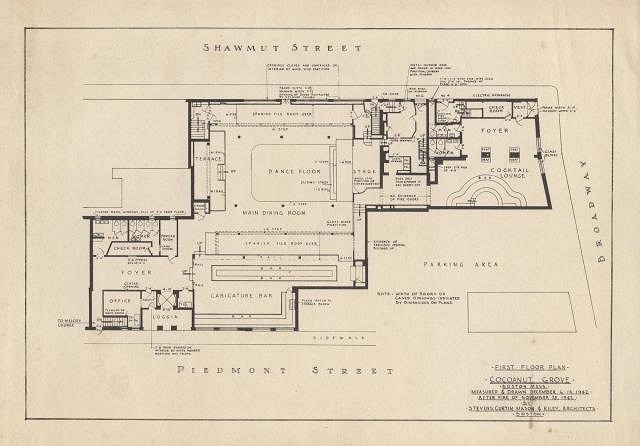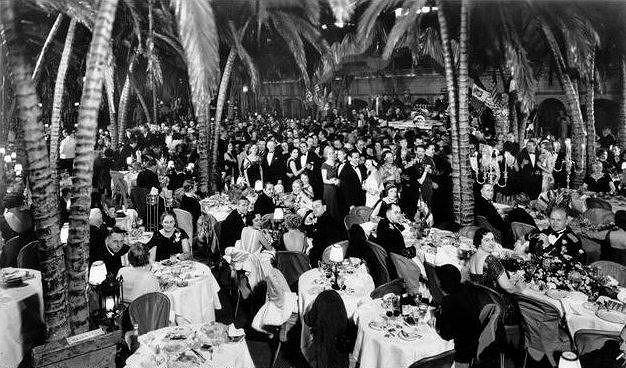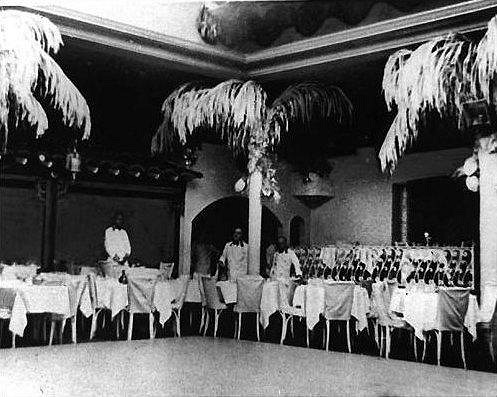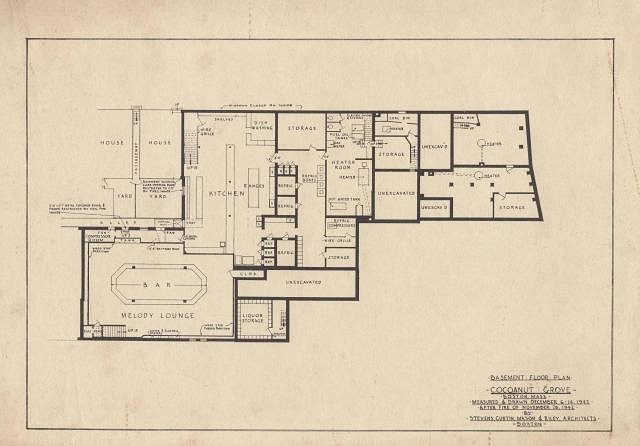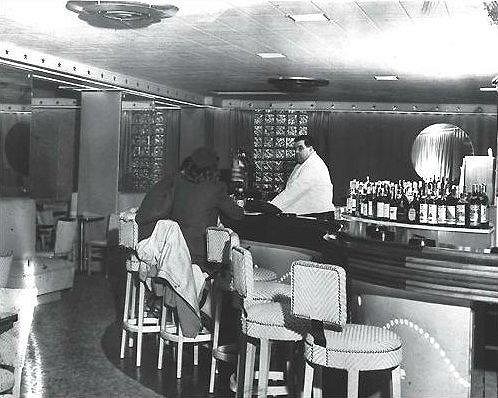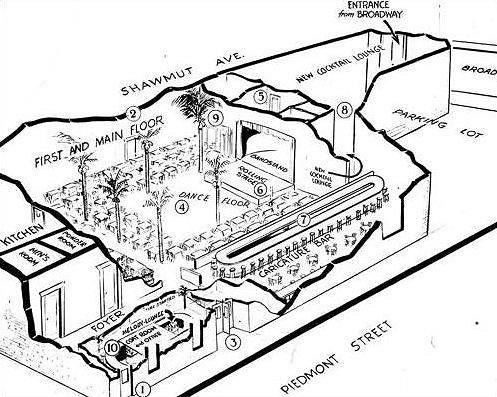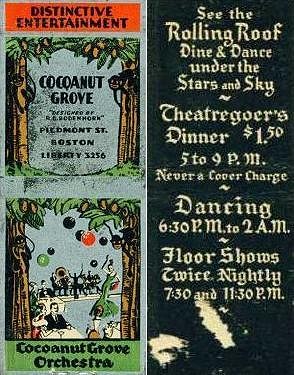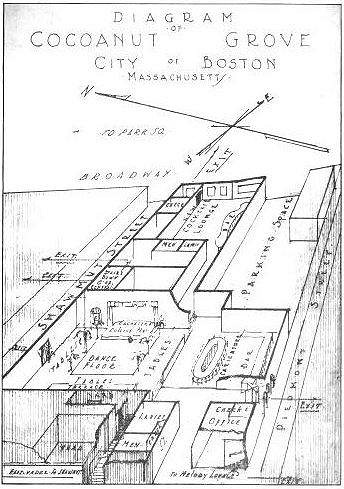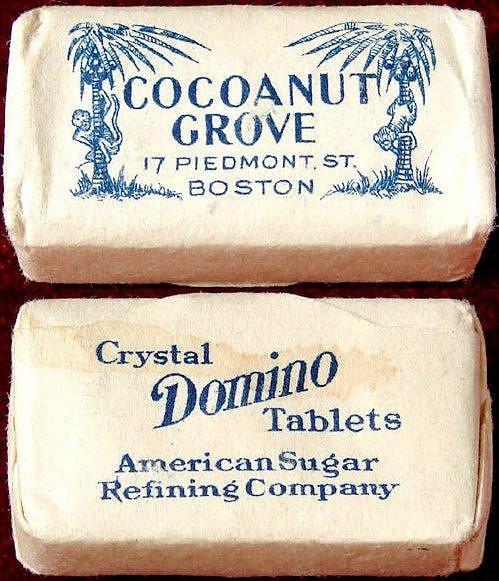Tiki Central / Locating Tiki
Cocoanut Grove, Boston, MA (restaurant)
Pages: 1 11 replies
|
P
pappythesailor
Posted
posted
on
Thu, Feb 23, 2006 9:38 AM
Name:Cocoanut Grove Description: |
|
P
pappythesailor
Posted
posted
on
Thu, Feb 23, 2006 9:40 AM
First, an account of the fire:The Cocoanut Grove inferno 50 years ago this week, 492 died in a tragedy for the ages By Jack Thomas, Globe Staff, 11/22/1992 "Flip through this," said retired firefighter Charles Kenney of Harwich, handing over a document with 11 pages of names. "Force yourself to turn every page. It gives you an idea of what the Cocoanut Grove fire meant to Boston. Page after page of names, 492 of them, all dead. It's hard to comprehend." Few events have taken a greater toll on Boston's psyche than the Cocoanut Grove fire 50 years ago next Saturday night. Hollywood rarely provides the drama of that 15-minute fire, rarely captures the horror and never conveys the agony endured by victims and their families for days, even years. There were heroes, such as the sailor who ran in three times to rescue people and on the fourth became a victim, and there were ghouls who rifled bodies for money and looted corpses of rings. Located in what is now Bay Village, the Cocoanut Grove was one of Boston's most elegant clubs. Lined with palm trees, it was a tropical paradise. In summer, the roof could be rolled back electrically for dancing under stars. Upstairs, in the dining room, shortly after 10, Mickey Alpert's band was about to begin the second show. Downstairs, the piano player was banging out "Bell Bottom Trousers" in the Melody Lounge, where the fire began. A young couple, wanting privacy, reached to a palm frond to unscrew a 7.5- watt bulb. Told by a bartender to restore the light, a 16-year-old busboy climbed upon a seat, and then struck a match to locate the socket. A moment later, someone noticed flame along the satin ceiling. At first, people were amused by the antics of waiters trying to douse the fire with seltzer water. Outside, meanwhile, the temperature was 28, the air dry. A few blocks away, firefighters were extinguishing flames in an automobile when they spotted smoke at the Cocoanut Grove. They were among the first to arrive at a fire that eventually involved 187 firefighters, 26 engine companies, five ladder companies, three rescue companies and one water tower. Downstairs, in the Melody Lounge, the fire picked up speed, swept across the ceiling and mushroomed up a stairwell, then exploded with tremendous force in the dining room. For some, the first indication of trouble was the screams of a woman, hair ablaze. The fire raced across the dance floor, as one witness said, with the speed of a 20-mile-an-hour wind. As people scrambled for exits, an employee in a gray suit, 5 feet 4, insisted that no one leave without paying the check. People celebrating one moment suddenly found themselves crawling along the floor or feeling along walls, battling fear and flames and darkness and terror and screams of agony, and amid the pandemonium of overturned tables and broken dishes, there seemed no escape from the searing heat and the acrid smoke that burned the eyes and scorched the throat. Some headed for doors to Shawmut Street, only to find them locked. In the darkness, others stumbled, were trampled and, overcome with smoke, never got up. Only a handful made it through the revolving door before it jammed and became a death trap in front of which scores of people died. The portico was a furnace, and firefighters were unable to get under the three arches of stucco, unable to penetrate nine feet to the revolving door, jammed with bodies, where they could see, through the glass, flames, smoke and men and women, succumbing and falling in a stack. Officer Elmer Brooks recalled that when rescuers tried to pull bodies from the door, arms and legs came off in their hands. Brooks scanned faces, hoping not to find his daughter, and at the same time cursed his selfishness. John Rizzo, 72, sat in his Lynn home the other day, peeling pages of his scrapbook back to the nightmare five decades ago. "I was 21. I was a waiter and so was my brother, Dan. The pay was union scale, $7 a week, but you could get $20 a day in tips. I was near the maitre d', Frank Balzarini, my friend. It was after 10 when Mickey Alpert got on stage to open the show with "The Star Spangled Banner." Suddenly, we heard a commotion and thought it was a fight, but from the foyer, we saw a ball of flame. Frank ran 20 feet to the revolving door, and that was the last I saw of him. The revolving door was where all those people got caught, and Frank was one of the bodies stacked up there." The story of the Cocoanut Grove is told in hundreds of articles in magazines and newspapers and in television documentaries and reports by the Fire Department and other agencies, and also in interviews with firefighters, journalists, doctors and employees, all of whom speak of the fire with awe. The impact was national. Doctors learned strategies for the treatment of burns that became standard at hospitals everywhere, and across the ntaion, cities tightened building codes to require lighted exit signs, doors that open outward and revolving doors flanked by conventional doors. "Everybody panicked. I knew there was a door across the dining room, but about 150 people were headed for it, and everybody was pressed together, arms jammed to our sides. The flame came down the side of the dining room like a forest fire, and within minutes, the stage was consumed with fire. Before I could get out, I got pushed through a door and fell head over heels downstairs into the kitchen and landed on other people." Boston was somber, and not merely because of the war. Thirteen days earlier, in the collapse of a building in Maverick Square, six firemen had been killed and 43 injured. "This is anything-can-happen day," wrote the Globe's Jerry Nason that morning, Nov. 28. It was a reference to the Boston College-Holy Cross football game, but his prophecy proved solemn. For every tragedy, there seemed to be a miracle of life. In losing to Holy Cross, Boston College also lost a chance to play in the Sugar Bowl. As a result, BC canceled a party that night at the Cocoanut Grove that surely would have resulted in the deaths of some football players. "At the foot of the stairs, I was lucky enough to get on my feet. Everybody was scrambling, trying to break doors to the stock room. I said forget it, they don't go outside. I saw a heavy lady, Mrs. (Katherine) Swett, the cashier. I said, 'Take the money, let's go,' but she said, 'I can't leave the money.' Later, I saw a big person burned to death, and it was her." The story hypnotizes people of all ages. Intrigued by a fire 20 years before her birth, Mary Renda, 30, of Medford, wrote to the Globe's Confidential Chat, asking for recollections, and among 30 replies was a letter from Bill Shriberg of Chestnut Hill, 89, who narrowly missed an appointment with death. "I was in my shop in Roxbury, repairing radios, when the Cocoanut Grove called to say the sound system was on the blink. I went over, replaced tubes, gave them a bill for $30, and left just before the fire. When I got back, the boys looked amazed. Milton Levin said, 'Thank God.' I said, 'For what?' and he said, 'Haven't you heard? The Cocoanut Grove's an inferno and people are dead!' I thought, well, God's got other plans for me." "I knew there was a little window over the liquor bar, and so I climbed up, shoved away bottles and started hoisting people out, head first. As the lights went out, I helped a busboy out, then climbed out myself to the alley, where I saw a lady on a second-story window, a chorus girl (Claudia Boyle). She yelled something about fur coats, and I told her she should jump, so she took off her shoes and jumped and landed on me, and we both fell to the ground, but I remember thinking, there are people screaming and dying and she's complaining about fur coats." Some bodies were charred beyond recognition, but many people inhaled smoke and slipped to the floor and died, untouched by flames. Kenney, the retired firefighter for whom the Cocoanut Grove is a hobby, recalled that he was 17 and came home from submarine school to visit his father, who'd fought the fire. "He was in bed, describing how bodies were stacked up at the door to Shawmut Street, but not all of them were dead. He pulled up his trousers and showed me the scratches on his legs where people had clawed at him to pull them out." "In the alley, I saw a lady on the ground with a sprained ankle and her husband was next to her, all cut. She said she wasn't going anywhere without her husband, so I picked him up, helped her up and carried him up the alley. When I saw cars, I knew we were safe, and we collapsed. A paddy wagon whisked them away, and I never saw them again. When I picked myself up, I saw a restaurant, Mario's, and went in for a shot of whiskey, then back out to look for my brother. I figured he was at a hospital. So I'd get into an ambulance with a body, go to a hospital, and if he wasn't there, I'd get into an ambulance back to the fire, and then to a different hospital, but I couldn't find him." As night deepened, the temperature dropped. Water on cobblestones turned to ice. Hoses froze to the ground. Newspaper trucks were appropriated as ambulances. From nearby bars, soldiers and sailors raced to assist. On the street, firefighters lugged out bodies and were treated for burned hands. Smoldering bodies, living and dead, were hosed in icy water. Some victims had ingested fumes so hot that when they inhaled cold air, as one firefighter put it, they dropped like stones. "It was cold and someone gave me a police blanket, which I wrapped around me. Here's the picture of me that appeared in the paper the next day. Three Navy lieutenants took me over to the Statler Hotel, where they gave us 40 blankets to carry back. I called my mother in Revere to let her know I was OK, and she asked about Dan. I said he'd gone to the hospital with a broken finger. It wasn't true, but I didn't want to worry my mother." On Sunday morning, edition after edition rolled off the press with five- inch headlines ever more ghastly: "SCORES DEAD IN NIGHT CLUB FIRE," and then, successively, 200 DEAD, then 386, 400 and finally 450. Throughout the morning, in front of the Globe, a mournful line formed of people waiting for the next edition, praying not to find the names of loved ones among the dead. Globe reporter Sam Cutler captured the grisliness: "The worst disaster in Boston's history last night snuffed out the lives of 450 merrymaking men and women in the blazing inferno of the famous Cocoanut Grove nightclub amid scenes of utter panic and horror. Crushed and trampled and burned as nearly 1,000 patrons, entertainers and employees fought desperately to gain the exits through sheets of flames, scores of victims were left lying on the floor, helpless. Others reached the streets enveloped in flame, only to die in agony in the street." "Altogether, we lost about 20 employees, waiters, chorus girls, a couple of checkroom girls. Buck Jones, the movie star, was there. He used to be my idol. My brother waited on him that night. Buck Jones had a cold and didn't want to come to the Cocoanut Grove, but they lured him there, and he got killed. There was a party of undertakers from Keene, a family of 10. I waited on them myself. One couple from the group didn't want to see the second show and went across to the Metropolitan theater, and when they got back, their whole family was wiped out." America was a different nation, Boston a different city. At Raymond's, Uncle Eph was selling a dozen metal soldiers for 95 cents. Headlines boasted: "How Japs Were Caught With Their Kimonos Down." Dorothy Dix advised soldiers, "Don't let any girl beg, entreat, weep, threaten or otherwise coerce you into marriage before you're ready." People were eating Crax and drinking Krueger and smoking Fatimas and brushing with Dr. Lyon's Tooth Powder. At First National, Rinso was 13 cents, five pounds of squash a dime. Ads said the way to stay strong on the home front was to drink Hood milk. Koussevitzky was conducting the Boston Symphony. Morton Downey was at Copley Plaza. People were dancing at the Tic Toc, Judy Garland was at Loew's in "For Me and My Gal," and folks were reading "Our Hearts Were Young and Gay." Outdoor Christmas lights were banned so as not to provide a target for aircraft. On radio, people listened to Gabriel Heatter, Bump Hadley, Gangbusters, Mildred Carlson, Our Gal Sunday and Hum and Strum. After reading about Marines on Guadalcanal, people turned to the comics for Mutt & Jeff. "It was 4 in the morning. I was getting tired, but a reporter asked me to sit on the back of a fire engine and tell him what happened. Then I took a taxi to a nearby hotel to see a cousin, a bellhop. He took me to his room and gave me a drink, then two, four, five, and finally got me a cab home, and as I was getting out, I saw two black limousines from a funeral home in front of my house and I knew my brother was dead." For months, Bostonians traded the anecdotes.
"When I got inside my house, I realized the limousines belonged to my cousin, who owned a funeral home, and my mother told me that my brother was alive, that the hospital had called and he was burned, but OK, so I changed clothes, and we went to the hospital to see my brother." Before her speech in Wayland a few nights ago, Dr. Anne Phillips, an expert on the Cocoanut Grove fire, made a point of examining a window as a potential exit in case of fire. "At the Cocoanut Grove, people did not respond intelligently. Some watched flames cross the ceiling, and it was not until one person started upstairs that others did. Even then, a hat-check girl wanted people to pay for coats. The way to overcome this is to teach people how to react to fear. "There were not many serious burns. The reason is that so many people died. Of those admitted to Mass General, only three had no respiratory problems because they had responded cleverly. One covered his face with a sweater, another with a dry napkin, and a third had the presence of mind to urinate on a napkin and put it over his face." "As we approached my brother's room, there was a line of beds, and I saw Bernie Fazioli from Everett. He said, 'Hi, Johnnie. Your brother's down four beds.' Dan was burned on his hands and his ears, but OK. We stayed a half hour. Then, in the lobby, I heard a woman scream. They said it was Mrs. Fazioli, whose husband was dead. I said, no, I just talked to him upstairs, and they said, well, he just died from smoke he'd inhaled." The toll would have been worse except that, because of the war, hospitals were well-stocked with bandages, plasma, saline, oxygen tents and intravenous units. A week earlier, a mock blitz by German Luftwaffe had been enacted to test Civil Defense workers. Nevertheless, the impact upon hospitals was stunning. At Mass General, as patients arrived, four priests administered last rites. For 75 minutes, Boston City Hospital averaged a new patient every 11 seconds. Of the first 200 victims to arrive, 150 were dead. Morphine was administered before doctors had time to determine if a patient were alive, and their foreheads were then marked with an "M," written in lipstick. Most victims died that night. It took 90 hours to identify all bodies. For 10 consecutive days, newspapers reported deaths. Scores of victims lingered in hospitals for months until the final victim died May 5. Mass. General said there would be no financial reward to doctors and it was unlikely the hospital would bill families. "We don't care if the hospital is ever repaid." "On Sunday, I got some rest, and my friend Billy picked me up and we returned a blanket to the police. They asked a lot of questions, two hours. Monday, I went to the Cocoanut Grove to get my clothes. There was a waiter in overalls. It was the only pants he had. You know who that was? Chico Adolf Cecchini, who's about 88 now, and he was head waiter at Locke-Ober's for about 40 years." Among the causes investigated was sabotage. As fire department historian Paul Christian recalled the other day, "There were a lot of servicemen in Boston, and people were nervous. You never knew if the Luftwaffe might fly over." Eventually, the busboy was exonerated. Although the cause was never determined, an investigation blamed the massive death toll on gross violations of fundamental principles of safety. At the hearing, firefighters raised bandaged hands to take the oath. Testimony revealed that the manager, James Welansky, had been dining with a police captain and an assistant district attorney, both blind to obvious violations. With 1,000 patrons, the club was 25 percent beyond capacity. Busboys were under legal age. A firefighter said he had inspected the club eight days before and found everything satisfactory. And yet, not only were decorations not fireproof, they were highly inflammable. The electrician who wired the Cocoanut Grove had no license, and he testified that the owner, Barney Welansky, had told him not to worry, that Welansky was "in with the mayor." Taxes had been cut mysteriously from $18,000 to $9,000. Not only did a revolving door become jammed, but other exits were locked, trapping scores of screaming victims. A plate-glass window that would have provided egress for 200 people was boarded up. The Portland Press Herald called it a "perfectly stupid way to learn elementary public safety." "On Tuesday, the waiters went to Frank's funeral. We were pallbearers. Do I think about the fire? Yes. Not as much, but I think about the waiters, and one night not too long ago, I had a dream. It was about Frank Balzarini, my friend." The Licensing Board ruled that no Boston establishment could call itself the Cocoanut Grove. Within two years, more than 400 suits were filed, but when assets were divided, survivors and families of the dead received checks for about $150. Of 11 men indicted, only Barney Welansky was convicted. Sentenced to 12 to 15 years, he served less than four, and in December 1946, ravaged with cancer, he was released from Norfolk Prison, telling reporters, "I wish I'd died with the others in the fire." Nine weeks later, he was dead. |
|
B
bigbrotiki
Posted
posted
on
Thu, Feb 23, 2006 3:14 PM
W-O-W-! What an amazing, tragic, twisted time warp! Reminded me about the Hamburg fire storm descriptions when, during a WWII fire bombing raid, people were boiled alive from the pure heat in the vicinity. Perfectly ghastly. And how times have changed..where are characters like this today?: "...There was a waiter in overalls. It was the only pants he had. You know who that was? Chico Adolf Cecchini, who's about 88 now, and he was head waiter at Locke-Ober's for about 40 years....." |
|
T
Tikiwahine
Posted
posted
on
Thu, Feb 23, 2006 3:51 PM
wow is right! I'm glad I read that. |
|
T
Tikisgrl
Posted
posted
on
Thu, Feb 23, 2006 4:23 PM
Amazing story Pappy. I've lived here in the area all my life but I don't remember seeing this detailed account of the fire and the aftermath. I will look forward to more pictures and information. Tikisgrl |
|
P
pappythesailor
Posted
posted
on
Thu, Feb 23, 2006 7:07 PM
Yeah, the first time I heard about the fire was from my Grandfather when, as a little kid I remarked that all the Christmas trees in stores were fake. They said that ever since the Cocoanut Grove fire, Christmas trees had to be artificial. There are a couple of books in the Worcester Public Library on the fire. I really hope to learn about the restaurant BEFORE the fire. |
|
P
pappythesailor
Posted
posted
on
Fri, Mar 3, 2006 6:10 AM
I felt kinda ghoulish reading thru accounts of the Cocoanut Grove Fire looking for evidence of tiki (or pre-tiki) but I gotta start somewhere. The main dining area of the Grove had seven, giant artificial palm trees but 7 palms to do not a tropical paradise make. I found a description of the downstairs Melody Lounge in Edward Keyes, "Cocoanut Grove": ..."The walls of the stairwell" (leading to the Melody Lounge and the only public exit) "were of unfinished wood and hung with fish netting, setting the tone for a vague sort of tropical exotica in prospect below. There, driftwood was set off with strips of rattan and bamboo, simulating coastal reeds, and in each corner rose a section of stylized palm trees with fronds" (not the giant palms upstairs)" overhanging the small tables and zebra-striped settees that hugged three sides of the room. Overhead, a deep-blue satin-like material billowed like a lowering night sky" (Cool!) "The only real illumination came from indirect lighting over the enclosed octagonal bar that dominated the room. There were pinpoints of pale light among the artificial trees--which were electrically with 7 1/2 watt bulbs interspersed among the greenery and cocoanut husks--but most of these were so artfully planted that their effect was little more than to cast a beguiling glow among the palms. This state of semidarkness was exactly what appealed to those who frequented the Melody Lounge..." If that's not a tiki bar, I don't know what is. |
|
C
captnkirk
Posted
posted
on
Mon, Mar 20, 2006 7:00 PM
A while back I watched a documentary on the History Channel called "Panic: Deadly Inferno" about tragic fires. It spent quite a bit of time on the Coconut Grove, and there was lots of before footage showing what it was like before the fire. I understand from their website the DVD Engineering disaster covers the fire also: If you are interested you can buy both these DVDs here: Panic Deadly Inferno or here Engineering Disasters #13 [ Edited by: captnkirk 2006-03-20 19:05 ] |
|
P

PockyTiki
Posted
posted
on
Wed, Mar 21, 2007 8:06 PM
Was just browsing through these forums and saw this post! Thought I'd throw in a random fact! My grandfather, back in WW2 was in the navy and was in Boston at the time! He and his buddies were in a cab for a night on the town, until they saw the fire. They got out of the cabs and ran to go helpout as much as they could. That's as much as I know. Cheers, all! |
|
E
exotica59
Posted
posted
on
Sun, Jan 31, 2010 10:01 PM
|
|
L
LostIsland
Posted
posted
on
Thu, Apr 4, 2013 3:24 PM
This event has haunted me for almost my entire life having watched a documentary about it as a child. It was the crossroads of my love for exotic/tiki culture and urban decay. Here are a few images I was able to track down.
|
|
BK
Big Kahuna
Posted
posted
on
Sat, Apr 6, 2013 2:33 PM
It's very difficult for any of us near Boston to think of this place as anything but a horrific death trap. It's a shame, because it looks like a pretty cool place, but the tragic loss of life will forever be it's only legacy. |
Pages: 1 11 replies



